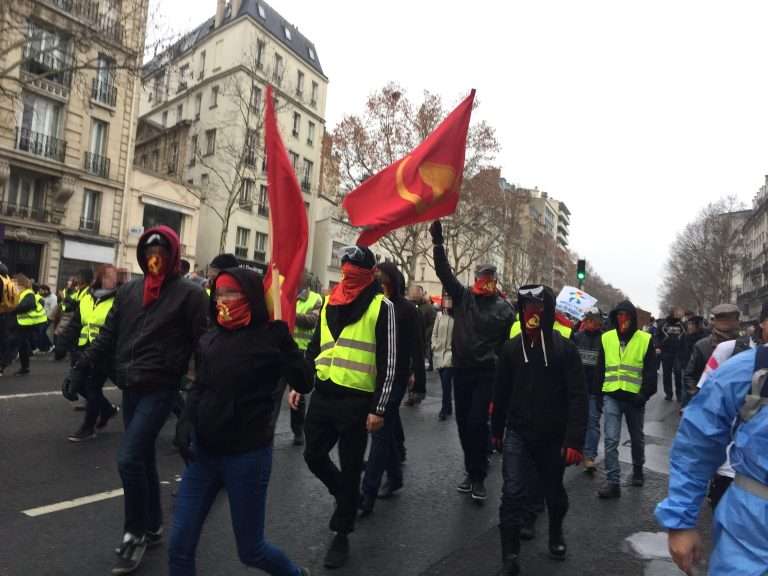By Ragnar V. Røed, written in 2017 as a short and simple introduction.
Norway is one of the world’s richest countries, with a special combination of a big raw material economy, imperialism and low population there has been less unemployment and poverty then in most european countries. But still there is hundreds of thousands marginalized in Norway. There exists a so called precariat, a part of the proletariat that has short term contracts, temporary positions and forced part-time. There are many people that are too sick to work one hundred percent, but that could do a lot of productive things if they got the opportunity. There are paperless refugees that could have been a part of society, but has to live partly in hiding and partly as slaves. We have hundreds of thousands of people that gets sick from stress and pressure with direct root from how production and the whole of society is put together. We have trans people and others that doesn’t fit in the “standards of normal”, that doesn’t fit into the small confines of society, that is harshly oppressed. Women still experience ridicule, abuse and violence from their partners, husbands and even complete strangers.
In other words there are hundreds of thousands of people that everyday can feel oppression and exploitation both physically and psychologically. People that has to every single day carry the burden and coercion of other people’s freedom to do as they please., for other people’s freedom to do as they please. There is hundreds of thousands of people, even in the best capitalist country, that dreams about and even cries out for a worthy life that the racist, partiarchical, imperialist-capitalist system can’t or won’t give them. Their hope doesn’t lie in salvation from above, or in charity from the bourgeois state, but from their own organisation, in struggle and revolution. Everything else are illusions and dreams. Some individuals can climb up and buy their freedom, but the masses of the oppressed marginalized is doomed to die on their knees in this system.
Norway has a proletariat. It is admittedly relatively well fed by the welfare state and imperialism and enjoys one of the world’s most unionized working lines. Parts of it enjoys so much from these goods, that they have become a labour aristocracy with both bourgeoise habits and thoughts. It is admittedly relatively well-trained and tamed, after 90 years of social democratic domination and betrayal. And is admittedly split and fragmented, after the large industry workplaces was dissolved and the workers collectives has disappeared. But the proletariat exists, it stands without power in today’s society, it does all the important work in the country and is the largest class in Norway. And the deepest masses, parts of the proletariat, is poor, marginalized and oppressed.
The proletariat is the revolution’s subject. It is the the most revolutionary class. Even when the majority of the proletariat slumbers and don’t struggle, is there no other class that can take the place of the proletariat. Only it has potential to organize itself as the vanguard to stand up against capitalism. Historically certain revolutionaries has had the biggest expectations from the petty-bourgeois intellectuals, to scientists and technocrats. They have hoped on a revolution from above, where the masses has played the role as the mouthpiece of the leaders or they have barely been allowed to be supplements to the revolution. Maoism underlines the leading role of the masses and principally that of the proletariat.
The petty-bourgeoisie can impress with their matter knowledge or skills and especially impress themselves and each other. But historically they have not played the role as the organising core and the driving force of the struggle. They can be the most enthusiastic revolutionaries one day, and then to give up the next – or embrace reactionary movements; peasant parties, religious sects, fascist groups. They have this in common with the lumpenproletariat who is permanently placed outside of the production, and on the side of and at the bottom of society. Also this group has had some revolutionaries placed trust in as the vanguard, but it also has a weakness that is unorganization, principal resistance against discipline, beliefs in conspiracy theories and is often unstable.
The proletariat finds and needs to find friends, allies, comrades among the petty-bourgeoisie and the lumpenproletariat. But the organizing power and core to build communism, is the organized revolutionary proletariat under leadership by its party. The proletariat is the propertyless class of workers and oppressed. It doesn’t only consist of miners and industry workers, which today there is very little of in Norway, but of the poorly paid, propertyless, subordinated and oppressed that make up the class of service workers, healthcare workers, construction workers, people living on provisional welfare, transport workers and so on. Historically the core of the class has been the proletarians who has been most concentrated, where one find proletarians in the largest numbers and in the most oppressed position.
Capitalism creates the proletariat in itself, because capital is created by exploitation of this class, but the proletariat must also become a class for itself. It must become self-aware, conscious about its position and its own potential. The first wave of proletarian organizing succeeded largely with this, most proletarians saw themselves as proletarians and placed weight on it. We can and need to succeed with this again on a larger scale.
Kjære leser!
Tjen Folket Media trenger din støtte. Vi får selvsagt ingen pressestøtte eller noen hjelp fra rike kapitalister slik som rasistiske “alternative medier”. All vår støtte kommer fra våre lesere og fra den revolusjonære bevegelsen. Vi er dypt takknemlige for dette. Vi overlever ikke uten, og du kan gjøre ditt bidrag ved å støtte oss med det du kan avse.
